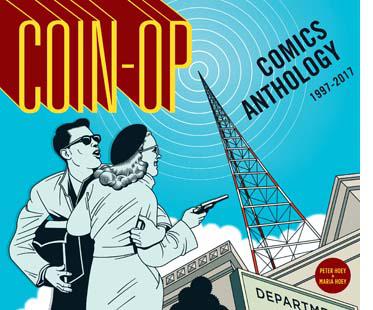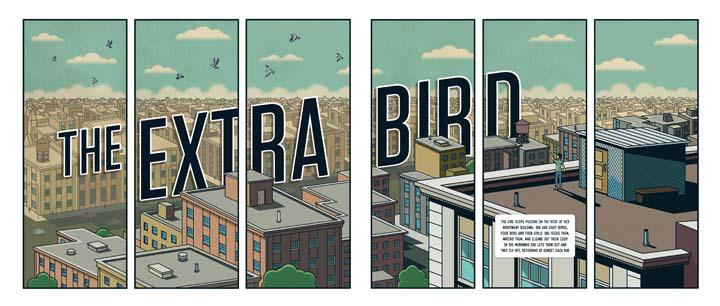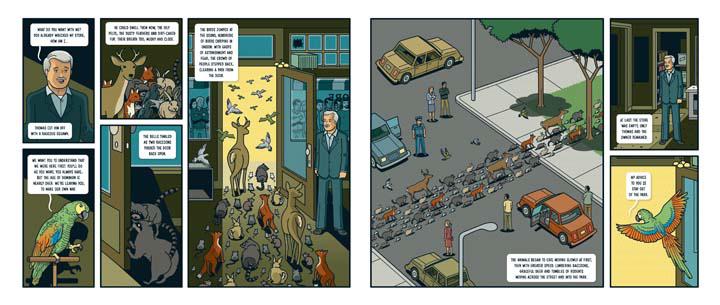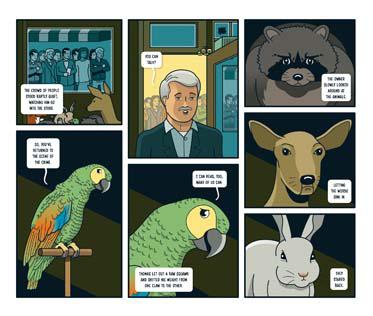Peter and Maria Hoey's Animal Stories
Peter and Maria Hoey, the sibling artist duo known for their indie comics and data-crunching art and illustration, have a new book coming out next week. They joined me for an email conversation on the eve of the book tour that begins in France, mid-March.
Peggy Roalf: As sibling artists, you seem uniquely suited to closing the gaps between an idea and a finished product. Could you talk about how you work as a team and share responsibilities on assignments and on books?
Peter Hoey: We’ve worked together since 1997. In the beginning it was mostly assignment illustration. I would sketch out ideas and usually do the line work. Maria would do the coloring. Fairly early on we started doing comics for Blab!, a comics anthology published by Fantagraphics. For those, we worked on everything together: story, drawing, layout and color. In addition, we collaborated on the tone of the stories.

Peter: We work on a lot of informational graphics and really, they’re a lot like comics in the way they tell a story with words and pictures. When {Monte Beauchamp,] the editor of “Blab!” called us up and asked it we wanted to try doing comics, we were up for it.
Maria Hoey: We are artists who are working illustrators. It is a life that allows/requires you to learn something new every day and tighten and refine how you present that information for the viewer. As artists the idea of making comics just seemed natural. We started self-publishing our work in 2008 (a few titles each year,) out of the desire to just make stories and beautiful books.
Peggy: Going against form or type seems to be part of your stylistic approach, like the parrot that doesn’t speak, in Animal Stories. How do you suss out the “what if’s” of a story before you start drawing?
Maria: All the characters, story arc and plot twists are in place before any drawing happens. The idea of a revolutionary parrot struck us as funny, because he’d refuse to “talk” to people. Good for him.
Peggy: Animal Stories goes beyond the idea of non-human creatures as metaphors for human ones. Do you each have pets? Do they offer ideas on interspecies behaviors for the book?
Did you have pets as kids? What are some of the most unusual pets you’ve sheltered [or encountered]?
Peter: We liked the idea of showing animals as having their own agency and agendas running parallel or in opposition to people. We grew up with dogs and both of us have dogs now. I live in rural California and wild animals are all around. Last week, three large turkeys showed up at the end of the driveway. They spent the day sunning themselves and eating sunflower seeds we set out. The next day they were gone.
Maria: Living in New York we have to coexist with a lot of creatures! I couldn’t wait to live in a dog-friendly building one day, and for the past 10 years I’ve had a dog named George. He’s even had his own headline in The New York Times.
Peggy: The stories in the new book are very suspenseful. What is there about animal behavior that offers ideas for a film-noirish plot, much like the one in “The Extra Bird”?
Maria: People can never really know everything an animal is thinking. They’re guided by impulses and senses that are unknowable to us. That mystery is at the center of all the stories.
PR: Wild animals in urban settings—or in places they really don’t belong—also seems to be a theme in Animal Stories. Could you speak to this idea as a metaphor for human behavior, or for the instability of the Pandemic age?
Maria: Animals and people out of place, on edge, and trying to make their way as best they can. That’s the world we live in
PR: The psychic difference between people and animals is evident in the drawing of the wild animals in the pet shop, three pages from the end of the book. The animals seem soft and nimble while the pet store owner seems rigid and intractable. What kind of observation—and where observed—went into this drawing?
Maria: The different body language of the people and animals communicates the distance between them. Ultimately, the animals transcend their situation while the people are left behind, trying to figure out what happened.

Could you tell the readers a little about how publishing comics differs from your assignment practice as illustrators? And what advice would you give to artists just getting started in comics?
Peter: The biggest difference is that assignment illustration involves working with others to accomplish what they want for their publication. With comics, it’s your story, and drawings. The design and production, plot, tone and pacing are all up to you. Our advice is to plan everything out as much as you can before starting, and realize that things will change as you do it. And most of those changes will be good.
Maria: Anyone can make a book, but most will not. Give it everything you have and then make your next one even better. If it works, keep at it.
PR: What do you feel is the best way for you to expand your audience and get books into your readers’ hands? Are you planning to attend the MoCCA Festival, in April in NYC?
Peter: For us, it’s a mix of attending comic shows (like MoCCA), hitting up comic books stores, and generally trying to put our work in front of people. Craft is important to us and we design our books to look and feel good in people’s hands.
Maria: Festivals are a great place for our books. After months of solitary work, we get to engage (literally) with people interested in our work and also fellow artists. It’s a tangible experience that is so different from clicking a “buy” button. Festivals have been one of the things we have missed the most during Covid, and we are really looking forward to being at MoCCA next month. The Society of Illustrators hosts a truly amazing show, and we, along with a hundred other artists, will be there exhibiting over two days.
Animal Stories (Top Shelf Productions 2022) is available here and here online
Upcoming Livw: Festivals and Book Events:
Angoulême International Comics Festival (3/17-3/20) Info
AWP Bookfair (Philadelphia) (3/23-3/26)) Info
MoCCA fest (New York) (4/2-4/3) Info
San Diego Comic Con (7/21-7/24) Info
Peter and Maria Hoey make pictures together. Trading back and forth from their studios in Northern California and Brooklyn, the brother and sister artists draw and animate for publications of all kinds. Their work has appeared in The Best American Comics, and BAC’s Notable Comics list, at The Society of Illustrators, and in many issues of American Illustration. Their accordion-fold book, The French Drop, is in the Spencer Collection of Illustrated Books and Manuscripts and Fine Bindings at the New York Public Library.
They also write, draw and design the two-time Eisner nominated comic series Coin-Op. In 2018, Top Shelf Productions published an anthology of their first six issues. Their Coin-Op Comics Anthology (2018) and their new graphic novel Animal Stories (2022) both received starred reviews from Publishers Weekly.
web shop: https://coinopbooks.com/
illustration: http://peterhoey.com/
twitter: https://twitter.com/CoinOpBooks
insta: https://www.instagram.com/coinophoey/
DARTinterview






